 |
Festung Wülzburg
Weißenburg, Bayern, Germany
|
|
 |
Constructed: 1588-1610
Used by: Margraves of Ansbach,
Prussia, Bavaria, Germany
Conflict in which it participated:
Thirty Years' War
|
The time: The eighth century AD. The place: What we would today recognize as Bavaria. The sitch: Frankish King Pippin the Short (714-768) is on a hunting trip in the vicinity of the remains of a Roman fort called Birciana, at what would later be the city of Weißenburg. He has become separated from his retinue, and is thrashing about the wilderness in a directionless fashion. Having determined that he must spend the night alone in the wild, he settles down at the foot of an old oak tree. In the darkness Pippin suddenly sees the ghostly, lit figure of a young, pretty Germanic girl, floating above the ground. This hottie ghost beckons him to follow, and honestly, who is not going to follow a young, pretty Germanic girl who is beckoning to them, be she a ghost or not?
|
 |
|
|
This glühendes mädchen leads Pippin to a nearby hilltop, whence he can see all the surrounding countryside in the moonlight. Amazingly, here is also where he is reunited with his hunting peeps. In joy of his salvation, Pippin orders that a church be built on this very spot: The church became a monastery, and the monastery became a starfort. The end. Thank you for reading the story of Pippin the Short and the Hottie Ghost. Tip your waitstaff.
Well, the shareholders have just informed us that we'll need to flesh this page out with a little more information, sooo...Whatever the real reason a Benedictine monastery came to be established atop Wülzburg Mountain in the first half of the eleventh century, it most definitely was there.
|
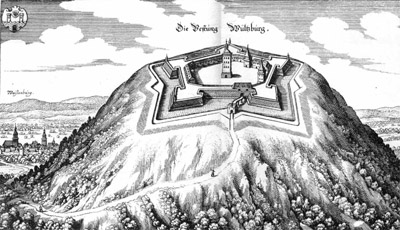 Festung Wülzburg around 1648, by Matthäus Merian (1593-1650). Can't argue with a perfect star atop a hill. Festung Wülzburg around 1648, by Matthäus Merian (1593-1650). Can't argue with a perfect star atop a hill.
|
 |
The Hohenzollern family became the rulers of much of southern Germany and Romania in the 14th century, and established themselves at Ansbach, just a smidge to the northwest of Weißenburg, in 1331. Having an up-and-coming ruling family such as the Hohenzollern around was great, but it tended to drag those regions into the many conflicts that such families generated.
Monasteries aren't generally of much help when anti-Hohenzollern forces could be approaching with ill intent at any moment, so the Benedictine Abbey of Peter and Paul atop Wülzburg Mountain was razed in 1588 at the behest of the Margraves (Earls) of Ansbach, to make way for a fortification of the Italian style.
|
|
|
...which of course means a starfort. Work began on the fort's ditch on June 25, 1588. Partly carved from the mountain's rock, it would grow to up to 75 feet wide and 30 feet deep. Festung Wülzburg's five bastions were named thus: Jungfrau (Virgin), Krebs (Cancer), Roßmühle (Horse Mill??), Kaltes Eck (Cold Corner) and Hauptwache (Main Guard). Surely soldiers stationed at Jungfrau kept an eye peeled for the aforementioned Hottie Ghost.
Festung Wüzburg may not have been optimally placed, as the peak of its neighboring mountain, Luabbichel, is about 50 feet higher, and history has shown that starforts with nearby higher ground tend to be indefensible once an enemy commands that neighboring peak...but that's what you get when your fort location is chosen by Pippin the Short. Of course he didn't intend for a fort to be built on Wülzburg Mountain, but a church. But he's not around to defend himself, so let's blame it on him.
|
Central European Protestants and Catholics had at one another in a most vicious manner in the first half of the 17th century, which is today remembered as the Thirty Years' War (1618-1648). Things were at their viciousest in and around Bavaria, which just happens to be where the starfort of our current interest lies.
The Margraves of Brandenburg slash Ansbach were either Protestant or in the Catholic League's way, so in 1631 Festung Wülzburg found itself facing a Catholic army headed by Johann T'Serclaes von Tilly (1559-1632). Von Tilly was a Dutchman who had been having a good deal of success on the battlefield of late, and whomsoever was in charge of our Festung's garrison saw fit to hand it over without a fight.
|
 |
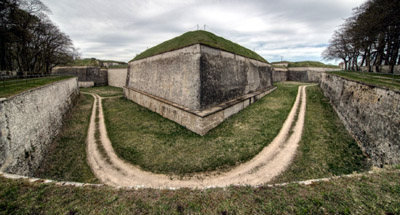 One of Festung Wülzburg's sexy corners. I would love to definitively declare which bastion this is, but there aren't a whole lot of distinguishing characteristics amongst those bastions from this angle. Aside from the fact that three of the five bastions sport jaunty guerites. This picture comes to us courtesy of Festungen.info, which does not pursue commercial purposes, but which nonetheless uses cookies to give you the best surfing experience, so please click their OK button. Starforts.com uses no cookies, because we don't care what your surfing experience is like. One of Festung Wülzburg's sexy corners. I would love to definitively declare which bastion this is, but there aren't a whole lot of distinguishing characteristics amongst those bastions from this angle. Aside from the fact that three of the five bastions sport jaunty guerites. This picture comes to us courtesy of Festungen.info, which does not pursue commercial purposes, but which nonetheless uses cookies to give you the best surfing experience, so please click their OK button. Starforts.com uses no cookies, because we don't care what your surfing experience is like. |
|
Maybe the garrison worried that it didn't have enough water to survive a lengthy siege? WRONG! Our Festung had, and still has, a well that plunges some 470 feet and is still providing fresh water, should anyone wish to take the trouble to fetch it. We are unaware of the garrison's religious and/or political leanings, but suspect that had more to do with the surrender than anything else.
Festung Wülzburg was capable of defending itself. This was proven by repeated failed attempts to capture it by the ever-troublesome Swedes, also during the Thirty Years' War. A fire damaged the fort's interior in 1639. Was this fire caused by Swedes? Misadventure on the part of the garrison? Hottie Ghost playing with matches? Unclear.
|
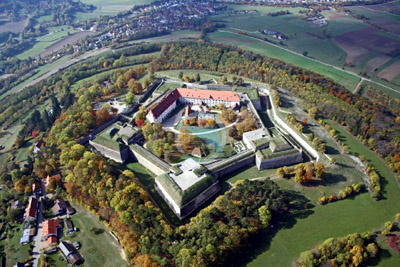 A lovely 45° shot of Festung Wülzburg, courtesy of Limes-Luftbild.de. Yes, we see your bigass watermark right in the center. Congratulations, you win. A lovely 45° shot of Festung Wülzburg, courtesy of Limes-Luftbild.de. Yes, we see your bigass watermark right in the center. Congratulations, you win.
|
 |
As was the case with many a European starfort, after the Thirty Years' War had wobbled to its conclusion Festung Wülzburg was used as a prison. One imagines there were those who wished to keep their starfort pure, prisonerless and fully ready to meet ye olde slings and arrows of outrageous fortune, but without an active threat, a starfort must have looked like an awfully tempting secure facility for governing entities to store the miscriental class.
In December of 1791, Charles Alexander (1736-1806), Margrave of Brandenburg-Ansbach, sold his principalities to Prussia's King Frederick William II (1744-1797), ending four centuries of Ansbachian sovereignty.
|
|
|
Our Festung was suddenly a Prussian Festung! Far from any area of contention, surely it continued in its role as a prison. Prussia's fortunes took a decided turn for the worse shortly thereafter: Their defeat at the hands of Napoleon (1769-1821) at the Battle of Jena and Auerstedt (October 14, 1806) subjugated them to the Corsican Tyrant (which was Napoleon) for the next six years. Napoleon did away with the ridiculousness that was the Holy Roman Empire, making Bavaria a proper kingdom in and of itself: Wülzburg was now a Bavarian Festung!
The Bavarians turned out to be those aforementioned starfort purists: Their Ministry of War spared no expense to renovate Festung Wülzburg so that it could be utilized as an actual fortification again, as opposed to a (admittedly very cool) prison.
|
A Bavarian infantry regiment uneventfully garrisoned our Festung until 1882, when the fort was sold to the city of Weißenburg, which still owns it today. The First World War (1914-1918) returned Festung Wülzburg to its role as a prison: French troops were detained therein, the most famous being none other than France's future president, Charles de Gaulle (1890-1970)!
A company commander, de Gaulle had been captured during the Battle of Verdun (March 1916). He spent the next 32 months as a POW, which period he livened up with five attempts to escape: Once hiding in a laundry basket, once digging a tunnel, once digging a hole through a wall, and once dressing as a nurse. Since only four attempts were described, we'll assume his fifth attempt involved wearing a bunny costume and catapulting himself over a wall (why not?).
|
 |
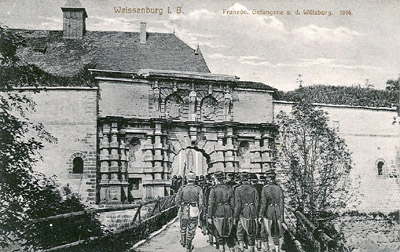 A First World War-era postcard, in which French prisoners of war are marched to captivity within Festung Wülzburg. They are entering through the fort's main gate, which is known as Das Prunktor: The Punctuator. Doubtless those POWs were promised a visit to The Punctuator by snickering German troops, whereupon the Frenchmen's moustaches quivered in apprehension. "C'est le Ponctuateur?!" they surely cried in relief when the jest was revealed. A First World War-era postcard, in which French prisoners of war are marched to captivity within Festung Wülzburg. They are entering through the fort's main gate, which is known as Das Prunktor: The Punctuator. Doubtless those POWs were promised a visit to The Punctuator by snickering German troops, whereupon the Frenchmen's moustaches quivered in apprehension. "C'est le Ponctuateur?!" they surely cried in relief when the jest was revealed. |
|
After each escape attempt, de Gaulle was transferred to higher-security facilities. Since he was reportedly imprisoned in Festung Wülzburg at the end of the war, we can extrapolate that our Festung was considered the highest-security prison in Germany!
In June of 1929 Bavaria's first Schullandheim, a sort of supplementary education system based on public works, was established at Festung Wülzburg. The Second World War (1939-1945) brought with it the need to imprison captured persons, again, so the Schullandheim people were kicked out and our Festung became a detention center for foreign civilians. Mostly it held Russian merchant seamen, who were so unfortunate as to have been in German ports in June of 1941, when Germany unexpectedly declared war on Russia. Next to our Festung is the Russische Friedhof, Russian Cemetery, in which 40 of those seamen are interred: Poor conditions and forced labor took an unnecessarily heavy toll on these poor guys...but then that's what the Nazis were all about, right?
|
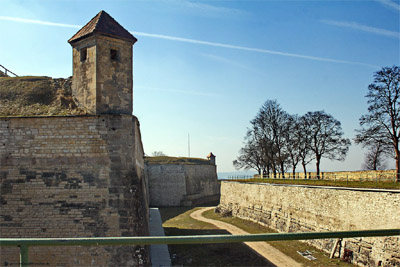 A couple of Festung Wülzburg's guerites, which are known in signature German compound word fashion as Scharwachttürme. A couple of Festung Wülzburg's guerites, which are known in signature German compound word fashion as Scharwachttürme.
|
 |
Thankfully, the Nazis were recognized for what they were (which was bad) and done away with. Following the war Festung Wülzburg was utilized as a refugee camp, and then a retirement home. In 1968 somebody noticed that our Festung was in amazingly good condition considering its age, and it was named a Nationally Important Monument The following year restoration efforts began.
For the rest of the 20th century the bill for this restoration effort was footed by Freistaat Bayern, the Free State of Bavaria...but in 2000 this responsibility was handed to the city of Weißenburg, which swiftly determined that it was unable to afford such pricey upkeep.
|
|
|
In 2006 Weißenburg's mayor, Reinhard Schwirzer (1947- ) announced that, henceforth, they'd pretty much be allowing Festung Wülzburg to collapse. This caused a stir, and reportedly smart people are presently thinking of ways to cause more money to be earmarked for the fort's survival.
Our Festung is still in good enough condition to allow regular guided tours. May through October the fort is open to visitors...and won't you enjoy a refreshing refreshment at the Bugwirt? We need a parting reference to the Hottie Ghost, let's see...Nope, I got nothin'.
|
 |
|
|
|
|
|
 |




